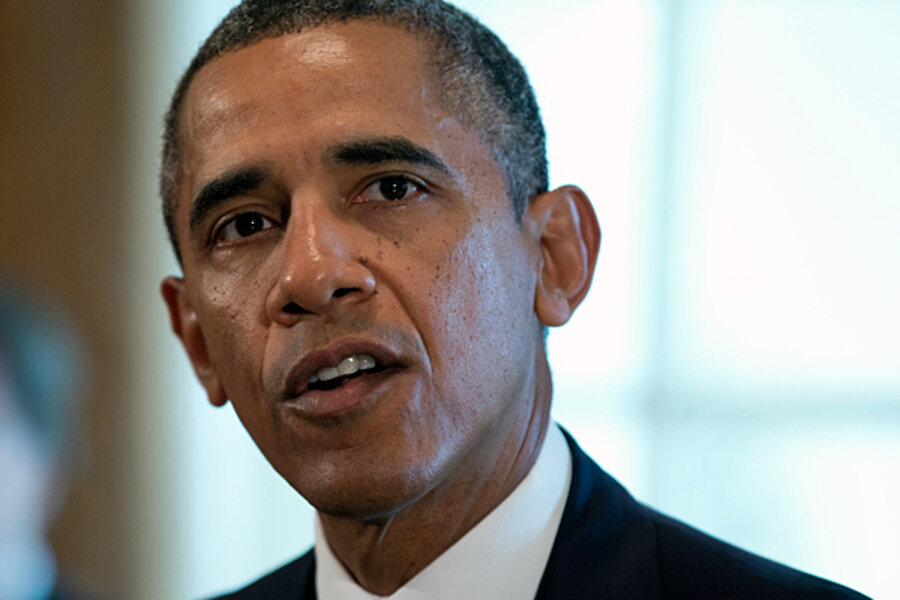Syria resolution: Why Obama proposal is failing the Goldilocks test
Loading...
| Washington
The resolution authorizing the use of force in Syria that Congress is expected to vote on sometime next week will no doubt undergo numerous tweaks and revisions, but the draft offered by the White House is so far failing the Goldilocks test.
Some members of Congress say what they’ve seen is too hard, others say it’s too soft. Unfazed, President Obama says he’s confident that by the end of a week or so of debate, the administration and the Congress will have come up with wording that is just right.
Speaking at the White House Tuesday as he met with Congressional leaders from both major parties, Mr. Obama said he welcomes the participation of Congress in fashioning a resolution on the use of force that both sends a “clear message” to Syrian President Bashar al-Assad and sets back his ability to use chemical weapons again.
Obama says he’s confident Congress is “going to be able to come up with something that hits that mark.”
The draft resolution the White House sent to Congress Saturday didn’t seem to be to almost anyone’s liking. Hawks said it was little more than a slap on the wrist to Mr. Assad and might be worse than doing nothing. More dovish critics said the proposed resolution was woefully open-ended and amounted to a slippery slope to deeper US involvement in Syria.
Given those two opposing perspectives, will it indeed be possible to find wording that is just right?
As proposed, the resolution states the following:
“The President is authorized to use the Armed Forces of the United States as he determines to be necessary and appropriate in connection with the use of chemical weapons or other weapons of mass destruction in Syria.”
The draft then specifies the two goals of the authorized use of force:
One is to “prevent or deter the use or proliferation … within, to or from Syria, of any weapons of mass destruction.”
The second is to “protect the United States and its allies and partners against the threat posed by such weapons”
For the “too hard” camp, the resolution will have to include some limits on how the president is authorized to use force before they will go along.
Calling the draft resolution “too broadly drafted” and a “blank check” for presidential use of military force, Rep. Chris Van Hollen, a Maryland Democrat, lists ways the resolution could be tightened to assuage his concerns.
One would be to explicitly rule out any American “boots on the ground” in Syria. Another would be to give any use-of-force authorization an expiration date.
The “too hard” camp may also conclude that protecting US “allies and partners” from “the threat posed by” WMDs may sound right, but in practice is very open-ended.
But one challenge in revising the draft resolution will be how to include such checks even while addressing the concerns of the “too soft” camp.
Several hawkish senators, including Lindsey Graham, Republican of South Carolina, and John McCain, Republican of Arizona, say the resolution will only be worthwhile if it triggers more robust US assistance to Syria’s moderate armed opposition, and steps to degrade the upper hand Assad currently enjoys in his fight with a militarily unequal opposition.
Senators Graham and McCain indicated tentative support for a resolution based on their meeting at the White House Monday. “I left the meeting feeling better than I felt before about what happens the day after, and that the purpose of the attack is going to be a little more robust than I thought,” Graham said, speaking with reporters afterwards.
McCain said that “the devil is in the details,” and spoke of arming the rebels with more powerful weapons and other steps to “degrade” Assad’s advantages over the opposition, such as its heavy artillery and air force.
But he did not specify if the details he seeks would have to be included in a resolution, or if administration assurances of what the authorized use of force would aim to do would be enough.
Aides with the Senate Foreign Relations Committee, which planned to hold a hearing Tuesday afternoon on the authorization of use of force, say they will get to work immediately on revisions to the resolution to make it more acceptable to more members.
But even as debate on the resolution proceeds, some analysts say Congress has to realize that there will be nothing narrow about authorizing the use of force in the case of Syria, even if wording seems air-tight about limiting the objective to Assad’s use of chemical weapons.
“To limit it to deterring the use of chemical weapons sounds narrow enough,” says Henry Sokolski, executive director of the Nonproliferation Policy Education Center in Arlington, Va. “But operationally, in order to do that you basically have to take on the regime,” he adds.
So the White House will have to answer the question: Is this resolution really about regime change (as some hawks would really like it to be) or isn’t it?






